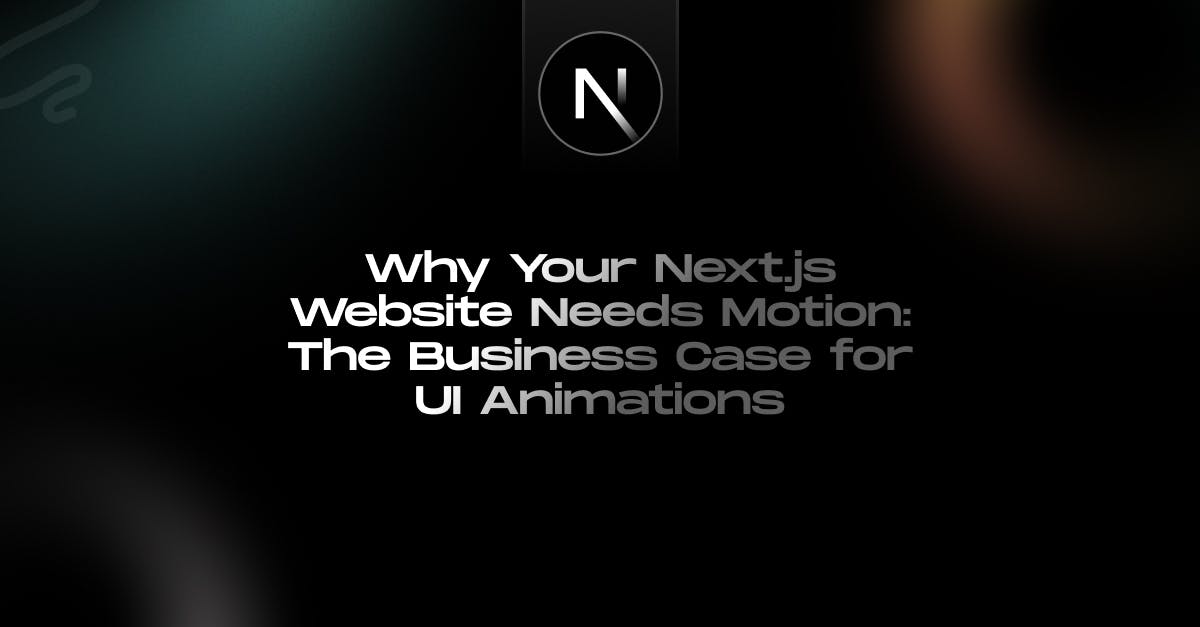October 19, 2025
Why Your Next.js Website Needs Motion: The Business Case for UI Animations

Md. Saad

Experiences, not just static pages, are what modern web users want. Motion design comes into play at this point. When Next.js, the best React framework for creating quick and scalable apps, is combined with contemporary animation frameworks like Motion (formerly Framer Motion), businesses can create websites that not only look good but also perform better in terms of engagement, usability, and conversions.
This article will examine the business case for UI animations and the reasons why motion is no longer an option for high-performing Next.js applications.
1. First Impressions That Convert
Making a first impression is something you can only do once. Studies show that users form opinions about websites in less than 0.05 seconds. Micro-interactions, delicate hover effects, and seamless page transitions give your brand a modern, polished look.
These animations are easy to incorporate into a Next.js website without compromising speed, guaranteeing that you look authentic and expert right away.
2. Better Storytelling and Brand Identity
Motion has its own language. You can draw attention to calls to action, highlight important products, and guide customers through the journey of your brand with the right animations. For example:
- One by one, each product feature can be highlighted with a staggered reveal animation.
- A brand's elegant or playful personality can be enhanced with animated navigation menus.
For companies, this means more than just being creative; it means giving customers a memorable and trustworthy experience.
3. Improved User Engagement
Animations are more than just beautiful extras; they draw attention and maintain interest. The user experience is made less frictional by scroll-triggered animations, interactive hover states, and animated feedback upon clicks.
A Motion-powered Next.js website can:
- Urge visitors to continue scrolling down the page.
- Improve the usability of buttons and forms.
- Make the trip smoother to cut down on drop-offs.
Users who are actively involved have a higher chance of becoming leads or customers.
4. Clearer Navigation and Usability
Businesses lose money because of confusion. Using animations to visually represent state changes can improve navigation's intuitiveness. For instance:
- Smooth fading or gliding page transitions let users know they are entering a new section.
- Tooltips with animations assist users without being overbearing.
- Users are reassured that the system is functioning by loading animations.
In conclusion, motion improves the user experience overall by removing uncertainty.
5. Increased Conversions Through Micro-Interactions
The tiny animations that show up when you hover, click, or tap are known as micro-interactions, and they are powerful conversion tools. They encourage customers to move forward and offer prompt feedback.
For example,
- Clickability is indicated by a button that gradually increases in size when hovered over.
- The shopping experience is enhanced by a cart icon that changes when an item is added.
These small details help businesses build trust, which in turn increases conversions.
6. Competitive Advantage in a Crowded Market
The majority of websites still use either too little or too much animation, which can be annoying. Your Next.js website will stand out in a crowded field if you use strategic motion design.
A website that is both high-tech and user-centred is produced by smooth, expert motion and quick load times (thanks to Next.js optimisation). It's rare to find that balance, but it can greatly benefit your brand.
7. The ROI of Motion in Next.js
ROI is ultimately the reason to invest in UI animations. A well-designed motion on a Next.js website can:
- Make the experience more engaging to lower bounce rates.
- Increase conversions through user-friendly interfaces.
- Increase retention because people prefer returning to a site that feels lively.
These are quantifiable benefits for businesses, not just design advantages.
Final Thoughts
There's more to adding motion to your Next.js website than just making it look up to date. The goal is to create a user experience that is ready for business and increases revenue, trust, and engagement.
You are losing opportunities to establish meaningful connections with users if your website is immobile and stagnant. Motion turns your Next.js website into an engaging experience that visitors will love, in addition to using it.
Want to elevate your Next.js website with purposeful motion design? Contact ustoday to discuss how animations can boost your user experience, engagement, and conversions.

